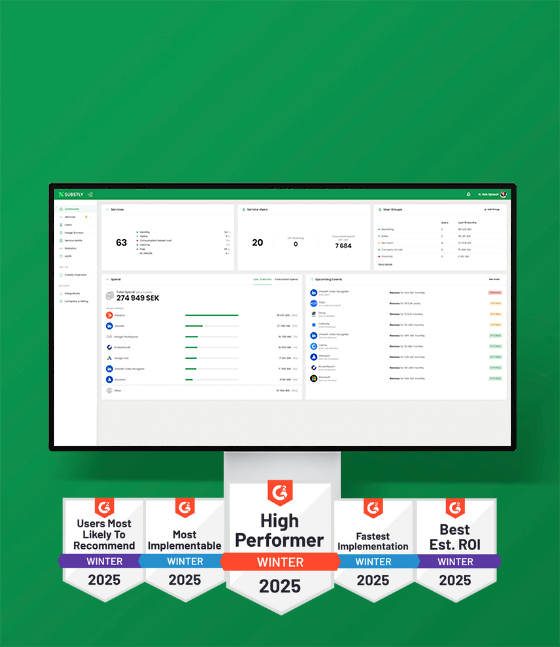Table of contents
SaaS management best practices for SMBs
1. Assess Your Needs
2. Embrace Centralization
3. Governance and Ownership
4. Find the right level of automation
5. Control Costs
6. Security and Compliance
7. User Training
8. Regular Audits
9. Vendor Management
Bonus: Key Concepts and Practical Skills Needed
Bonus: Using a SaaS management Platform vs. Self-Managed
Key takeaways
- Effectively managing SaaS applications is a new management challenge but crucial for small and midsized companies that want to maximize productivity and efficiency.
- By meeting the minimum requirements of the key concepts and practical skills of SaaS management, you can effectively harness the benefits of SaaS solutions and create a streamlined and productive technology environment.
- With its ability to enhance efficiency, control costs, improve security, and facilitate growth, SaaS management platforms empower you to maximize your software investment.
Introduction
In today's digital age, Software as a Service (SaaS) tools have become essential to streamline operations and enhance productivity. However, the increasing number of SaaS solutions can quickly lead to chaos and inefficiency without proper management. In this article, we will look into SaaS management best practices tailored to the needs of small businesses, answering the question about do organizations need SaaS management and helping you make the most out of your software investments while maintaining control and efficiency.
What is SaaS management?
SaaS management refers to effectively acquiring, monitoring, optimizing, and maintaining the collection of SaaS applications a business uses.
.jpg?width=500&height=384&name=SaaS%20Management%20-%20tasks%20-%20screen%20-%20small%20(1).jpg)
It involves selecting the right tools, managing subscriptions, ensuring security and compliance, integrating applications, and monitoring usage levels.
A well-executed software management strategy allows you to harness the benefits of cloud-based software while avoiding the challenges of disorganization between business units, overspending, and security vulnerabilities.
Here are the 9 best practices of SaaS management for small and mid-sized businesses:
1. Assess Your Needs
Assessing your business's specific needs is crucial before delving into the world of SaaS solutions.
Take the time to identify the challenges you're facing, whether it's streamlining communication, enhancing project management, or improving customer relationship management.
Pinpointing these pain points provides a clear roadmap for selecting the right SaaS tools that align with your unique requirements.
This strategic approach ensures that you invest in software that directly addresses your business challenges and prevents unnecessary spending on irrelevant applications that could dilute your budget.
2. Embrace Centralization
Centralization is a cornerstone of effective SaaS management. Actually, organizations that fail to manage SaaS life cycles centrally are five times more susceptible to a security breach or data loss.
Begin by creating a master list that documents all the SaaS products your business utilizes. This simple spreadsheet template will get you started and give you broader visibility.
The inventory you create becomes your control center, enabling you to track what tools are currently in use, who within your organization is responsible for each tool, and the associated costs.
This approach simplifies user access while providing a centralized dashboard for oversight.
You could also consider employing a management system such as a SaaS management tool offering more streamlined processes, automation, and collaboration features.
3. Governance and Ownership
You should define clear ownership and governance roles for each SaaS product to ensure accountability and prevent confusion.
Designate individuals or teams responsible for managing, maintaining, and overseeing each tool.
This clarity ensures that each application is properly managed, updates are implemented timely, and any issues are addressed promptly.
A well-defined governance structure streamlines operations and prevents potential bottlenecks.
4. Find the right level of automation
While automation of SaaS management can offer numerous benefits, SMBs face unique challenges that require a tailored approach to automation as they have valid reasons not to pursue these approaches to the same extent as their larger enterprise counterparts.
One of the pillars of good SaaS management for SMBs is understanding the purpose of automation and finding the right balance between manual and automated processes.
By striking this balance, SMBs unlock the benefits of automation while empowering their organizations to thrive in the digital landscape.
With that said, the power of SaaS tools multiplies when they integrate with each other.
While selecting tools, prioritize those that offer native integrations or APIs (Application Programming Interfaces) when applicable. These integrations break down data silos, foster collaboration, and reduce the need for manual data entry.
The ability for different applications to communicate and share information fluidly enhances your operational efficiency and empowers your team to work more cohesively.
5. Control Costs
The subscription-based pricing models of SaaS products lead to unforeseen and unwanted costs with improper spend management.
In fact, companies that fail to attain centralized visibility on SaaS overspend by at least 25%.
Regularly review your software subscriptions to ensure you're optimizing your budget.
Identify and cancel underutilized or redundant tools that no longer serve your business's needs.
Negotiate with vendors to explore opportunities for cost reduction or advantageous terms.
Consider committing to annual or longer-term contracts if it aligns with your strategy since it often leads to significant discounts.
6. Security and Compliance
Protecting your business and customer data is of paramount importance.
There is a 5x higher risk for cyber incidents for companies that are not managing their SaaS tools' life cycles centrally.
If applicable, prioritize SaaS tools that adhere to industry-specific security standards and compliance regulations, such as GDPR or HIPAA.
Utilize encryption to safeguard sensitive information and implement multi-factor authentication (MFA) to bolster access security.
Regularly conduct security audits to identify vulnerabilities and ensure your chosen applications maintain a robust security posture.
7. User Training
While adopting new SaaS tools can boost efficiency, their true impact is realized only when employees embrace and effectively use them.
Invest time in comprehensive user training and onboarding processes.
Ensure your employees understand how to navigate the tools and grasp the features and benefits directly impacting their roles.
Beyond teaching the mechanics of the software, training should highlight how each tool contributes to employees' roles and the broader company objectives.
Regular refresher sessions and user feedback loops help identify areas for improvement and ensure that the software is utilized to its fullest potential.
A well-trained workforce is more likely to embrace the software fully, leading to increased productivity and better utilization of the tools' capabilities.
8. Regular Audits
Monitoring the usage and performance of SaaS tools is an ongoing process that ensures the tools deliver the expected benefits.
Explore ways to understand and optimize the software usage. This involves adjusting settings, utilizing advanced features, or integrating applications more effectively.
Don't underestimate the importance of SaaS user management as a part of your software management process.
Regular audits are pivotal in controlling your software ecosystem and SaaS license usage.
Except for periodically assessing application usage levels, you should regularly track expenses and identify any potential security risks.
This practice ensures that your chosen tools align with your business goals and that any necessary adjustments can be made promptly to maximize the value of your SaaS investments.
9. Vendor Management
Building strong relationships with SaaS vendors contributes to successful software management.
Regular communication fosters a better understanding of product updates, security enhancements, and changes in pricing or terms of service.
Maintaining open lines of communication also allows you to provide feedback and influence the development of features that align with their needs.
Establishing a rapport with vendors can lead to more favorable agreements and better customer support, which is crucial in ensuring a smooth and productive SaaS ecosystem.
%20(1).jpg?width=800&height=2000&name=9%20SaaS%20Management%20Best%20Practices%20for%20Small%20Businesses%20-%20infographic%20(4)%20(1).jpg)
Bonus: Key Concepts and Practical Skills Needed
Effectively managing SaaS products demands a foundational understanding of key concepts and practical skills. While complex technical expertise might not be necessary, certain minimum requirements are essential to navigate software management successfully.
Fundamental SaaS Understanding
Small business owners and decision-makers must understand Software as a Service (SaaS) principles. This entails understanding the cloud-based nature of SaaS tools, the subscription-based model, and how these applications can enhance business operations. This baseline understanding forms the foundation for informed software adoption and management decisions.
Basic IT Literacy
While advanced technical skills are not obligatory, basic IT literacy is crucial. Familiarity with terms like user access management, data security, and integration is essential. This basic technical awareness empowers stakeholders to engage effectively with SaaS management tools, facilitating smarter application selection and integration decisions.
Security Awareness
An awareness of data security best practices is indispensable. Understanding how to safeguard sensitive business and customer data from breaches and unauthorized access is paramount. You should prioritize applications with robust security features and actively educate yourself on industry-specific compliance regulations to minimize risks.
Budget Management Skills
A foundational understanding of budget management is vital. Businesses should be capable of evaluating the cost-effectiveness of each SaaS product, considering whether the benefits align with the expense. This proficiency helps prevent overspending on unnecessary tools and maximizes the value derived from the software investment.
Strategic Decision-Making
Strategic decision-making involves considering long-term impacts over short-term gains. Businesses must evaluate how a SaaS tool aligns with its broader business strategy, growth objectives, and integration capabilities. This skill ensures software choices align with the company's vision and goals.
Training and Communication Proficiency
Effective communication and training skills are essential to ensure staff comprehends the purpose and usage of new SaaS tools. The ability to convey the advantages of a tool and provide proper training equips the team to utilize the software to its fullest potential, optimizing its impact on daily operations.
Adaptability and Learning Mindset
The technology landscape is ever-evolving. Businesses that embrace adaptability and a continual learning mindset fare better in keeping up with SaaS advancements. Staying informed about emerging trends, features, and security practices enables the business to stay competitive, secure, and prepared for changes.
.jpg?width=600&height=428&name=Key%20Concepts%20and%20Practical%20Skills%20for%20successful%20SaaS%20management%20-%20presentation%20-small%20(1).jpg)
Bonus: Using a SaaS management Platform vs. Self-Managed
While initially appealing, managing SaaS products without a SaaS management tool leads to challenges and limitations as businesses grow.
The familiarity and direct control over software choices often come at the cost of disorganization, inefficiency, security vulnerabilities, compliance risks, and limited scalability.
Advantages of managing SaaS apps without a SaaS Management Platform
For companies with a limited number of SaaS tools, managing them without a dedicated platform might initially appear straightforward.
Employees are often already familiar with the tools they use daily, and decisions can be made directly by the business owner or IT personnel.
This direct control over software choices can provide a sense of autonomy and ownership.
In addition, there may be apparent cost savings in the short term. Since there's no need to invest in a separate SaaS management tool, you can allocate resources differently, especially in the early stages of operation.
These initial savings could be redirected towards other pressing needs, offering flexibility in budget allocation.
Advantages of managing SaaS apps with a SaaS Management Platform
As the number of SaaS tools grows, the limitations of managing software without a dedicated platform start to reveal themselves. What might have initially seemed manageable can quickly become chaotic and inefficient.
Without a centralized system in place, it's all too easy to lose track of which applications are in use and which employees have access to what tools.
This lack of oversight leads to duplicated efforts, inefficiencies, and overlaps in functionality. Manual user access and permissions management consumes valuable time and introduces a higher risk of errors, potentially compromising security and overall functionality.
%20-%20small.png?width=500&height=384&name=SaaS%20Management%20platform%20-%20definition%20-%20computer%20screen%20(1)%20-%20small.png)
Companies attempting to manage security and compliance requirements for multiple applications independently face considerable challenges. The absence of a unified platform leads to vulnerabilities and breaches, exposing your business to unnecessary risks.
The absence of dedicated reporting and analytics features hinders effective decision-making.
Without insights into how applications are used, their performance, and their cost-effectiveness, you lack the data to optimize your software ecosystem.
This lack of visibility leads to missed opportunities for improvement and growth.
As you aim to maximize your software investments and thrive in a competitive environment, adopting software management and using a SaaS management tool should become increasingly clear.
By embracing SaaS management tools, you can efficiently navigate the digital landscape, ensuring a solid foundation for sustained growth and success.
If you work in a small or medium-sized business and seek a SaaS management platform with a short learning curve that is user-friendly and strengthens the cooperation between IT and Business, consider exploring Substly or get a personal introduction to see if it suits your needs.

.jpg)


